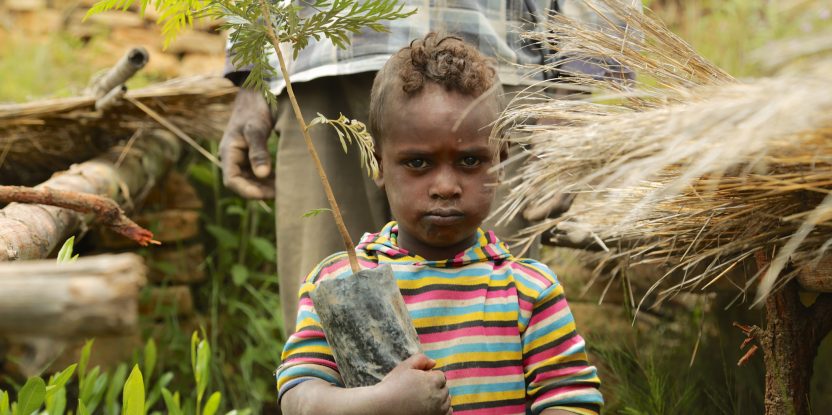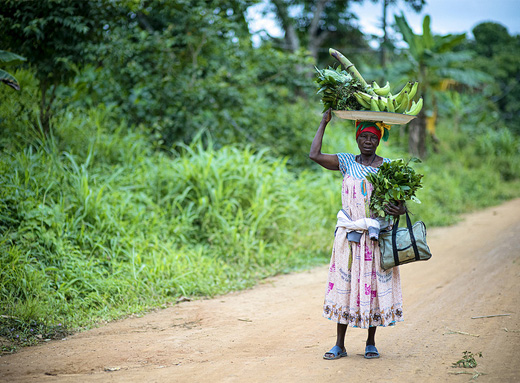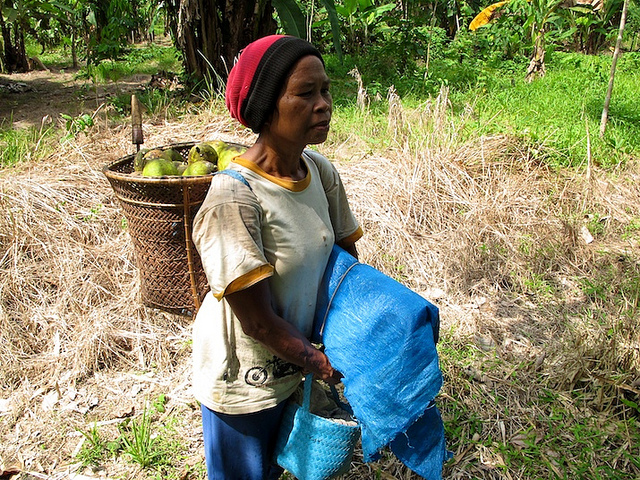
Amina*, a young mother of four, lives in a rural village in the Oromia region of Southern Ethiopia.
At 2,000 meters above sea level, the climate is temperate, soils are fertile, and unlike many parts of the country, there’s plenty of space for people to grow the crops they need to feed their families and make a living.
“From an agricultural point of view, you would say that this is a very blessed area,” says agronomist Frédéric Baudron, one of the lead scientists in a new study on forests and dietary diversity from the International Maize and Wheat Improvement Center (CIMMYT) and the Center for International Forestry Research (CIFOR).
But each time Amina weans a child, around the age of two, the child’s hair begins to turn yellow and fall out — signs of acute malnutrition. “It’s quite shocking to see such things,” says Baudron. “You feel like, wow, this place should not be experiencing this kind of problem.”
So what’s going on? Food security is high here. Most people are getting all the calories they need from the wheat and maize that grow easily and abundantly in the region. But many suffer from the “hidden hunger” of vitamin and mineral deficiency, which is estimated to affect around two billion people worldwide.
Research links dietary diversity — eating a range of foods and food groups — with getting all the vitamins and minerals one needs in order to thrive. And recent case studies have connected people’s proximity to forests with higher levels of dietary diversity, mostly through gathering food directly from the forest, and selling forest products to buy other kinds of food.
CIMMYT and CIFOR’s new study charts another, less direct way that forests help people eat more diverse diets — through flows of nutrients “from the forest, to the soil, to the crop, and then to people,” explains Baudron.
NOURISHING NETWORKS
Researchers compared dietary diversity in three zones classified as near, intermediate and distant from the southern Ethiopian state forest of Munesa. According to Baudron, the forest represents a somewhat rare haven of biodiversity in the population-dense country, characterized by lush waterfalls, majestic podocarp trees, Colobus monkeys and endemic birds.
Locals don’t tend to forage for food in this particular forest, and are forbidden to sell forest products for income. But the study shows decisively that dietary diversity is highest in the zone closest to the forest — even though it is the furthest away from markets which, some conventional wisdom suggests, should be facilitating access to a wider range of food products.
How is this happening? Baudron says the forest is “acting as a site of nutrient accumulation, and then livestock vector these nutrients from the forest to the farms through manure,” increasing the fertility of these farms and allowing the production of a range of crops, including nutrient-dense ones.
As he explains, the forest provides a ready supply of fodder for livestock, allowing people living close by to keep bigger herds producing more manure; and the availability of firewood also means they are less likely to burn their stock’s manure as fuel.
So, people who live closer to the forest have more nutrient-rich manure available to use in their farm, and tend to concentrate it in home gardens, where they grow a wide range of foods, creating “real hotspots of dietary diversity,” says Baudron. They also have access to more animal products such as milk, eggs and meat from the larger herds they are able to maintain.
TRADEOFF OR SYNERGY? AGRICULTURE AND BIODIVERSITY
In the bigger picture, this study highlights “the limits of the conventional approach to agricultural intensification, and argues for diversification,” says Baudron. As an agronomist, he says, “I was trained to think that increasing food production will always lead to declining biodiversity and that biodiversity is not really an input into agriculture … but it is.”
In his sixteen years of experience exploring the interaction between biodiversity, forests and agriculture, Baudron is often struck by the fact that “the landscapes that have been most transformed for food production are not always the most productive.”
And the Munesa forest study provides a case in point: while farmers living furthest from the forest use more intensive agricultural techniques, the landscape closer to the forest actually produces just as much maize and wheat, and a large diversity of other food items, more wood products and more livestock feed for the people who live there, he says.
The case also speaks to the failure of markets to attend to dietary diversity in many parts of developing countries. “In remote locations like this one, the market doesn’t work very well, and production diversity is very important,” says Baudron.
“So I think this is good proof against some of the statements that have been made in the past few years about the market solving under- and mal-nutrition — I think that’s a bit naive in lots of places.”
Instead, he says, we need to start looking at alternative approaches to intensification; alternatives to the conventional model focusing on staple food crops, external inputs, and extreme simplification of landscapes.
“I think maize, wheat and rice will remain very important in terms of calorie intake, but we also need to think about dietary diversity and the need for other things. So this approach of looking at the whole landscape makes a lot of sense — for diet, for income, for biodiversity, and for agriculture itself.”
Preserving and restoring forest cover, he says, is an important part of the picture. “We are trained to think in terms of trade-offs, but not in terms of synergies. And there are some very real synergies between biodiversity and agriculture, which I think we tend to have forgotten.”
And it’s stories like Amina’s that motivate him, and others, to remember.
*Names have been changed
We want you to share Forests News content, which is licensed under Creative Commons Attribution-NonCommercial-ShareAlike 4.0 International (CC BY-NC-SA 4.0). This means you are free to redistribute our material for non-commercial purposes. All we ask is that you give Forests News appropriate credit and link to the original Forests News content, indicate if changes were made, and distribute your contributions under the same Creative Commons license. You must notify Forests News if you repost, reprint or reuse our materials by contacting forestsnews@cifor-icraf.org.

